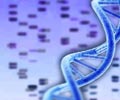About
Unlike a conventional fingerprint that occurs only on the fingertips and can be altered by surgery, a DNA fingerprint is the same for every tissue, and organ of a person. It cannot be altered by any known treatment.
Fingerprinting with ink and paper, based on fingertip ridge patterns is the standard method for personal identification. Fingerprints are constant throughout life, fingerprints can be used to distinguish one person from any other. Similarly the DNA of every individual is also unique in its own way. Actually the method should be called simply DNA printing or DNA typing since it has nothing to do with the fingers. The degree of variation in bands from one person to another is so large that the theoretical probability that the bands seen in one individual are present in another unrelated individual may be in millions. The advantages over fingerprints are numerous. DNA can be isolated from any part of the body, skin cells, blood or blood stains or semen.

The human DNA is different from other living organisms Hence blood of an animal will have different DNA sequence and characteristics. Hence DNA fingerprinting is a very quick way to compare the DNA sequences of any two living organisms.
However some of the disadvantages of DNA fingerprinting are:
- It requires further standardization and quality control, to be universally accepted as a tool.
- There are only a few reliable labs around the world that can give accurate results.
- There is also 1 in 50 billion chance of two DNA sequence being similar.
Application of DNA Fingerprinting
- It is currently employed in paternity disputes
- Identification of bodies of soldiers killed in war. It was also used for identification of the body of Nazi physician Joseph Mengele, the so-called "Angel of Death." In fact it has been used a to reunite a kid lost in the Tsunami with his parents.
- To diagnose inherited disorders in both prenatal and newborn babies, like:
- Cystic fibrosis
- Sickle cell anemia
- Thalassemia
- Hemophilia
- Huntington's disease
- Alzheimer's Disease (Familial Type)
- Huntington's Chorea
- Marfan's syndrome
Many other similar disorders can be diagnosed
- Biological Evidence to Identify Criminals: Where fingerprints are not available but biological specimens are available like blood or semen stains, hair, or items of clothing at the scene of the crime then these items may prove to be valuable sources of DNA of the criminal. Since the year 1987, innumerable cases have been solved with the help of DNA fingerprint evidence.
- Personal Identification - DNA maybe the best way to identify a person as all body tissues and organs contain the same DNA type. The specimen required also is very small. In fact the US army has been doing DNA fingerprinting of all its soldiers and has a huge databank. The DNA method for personal identification is far superior to the dental records and blood typing methods that were popularly being used.







